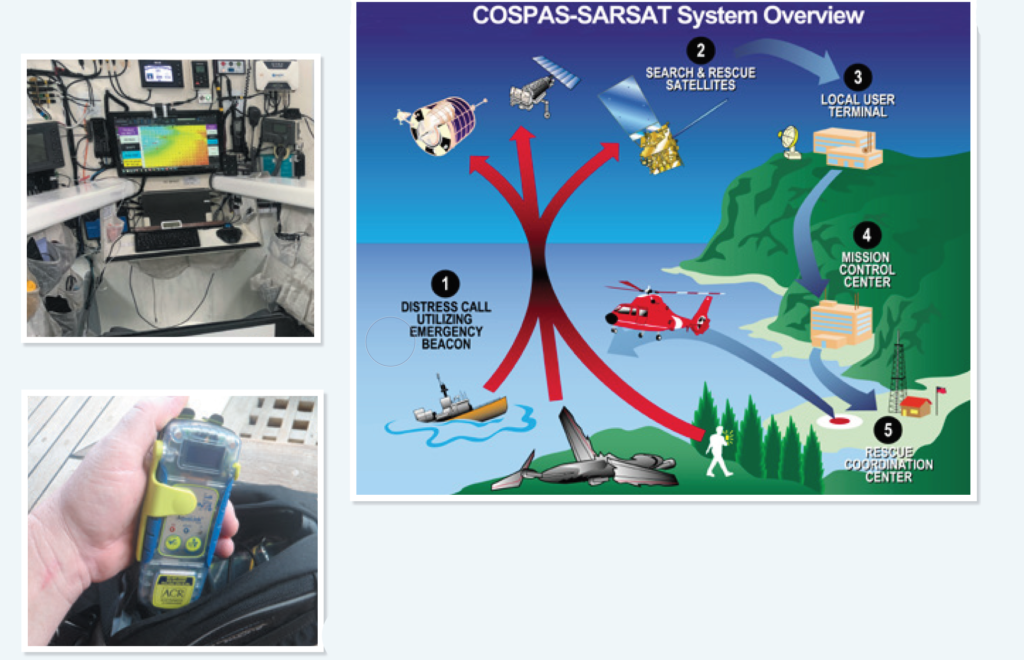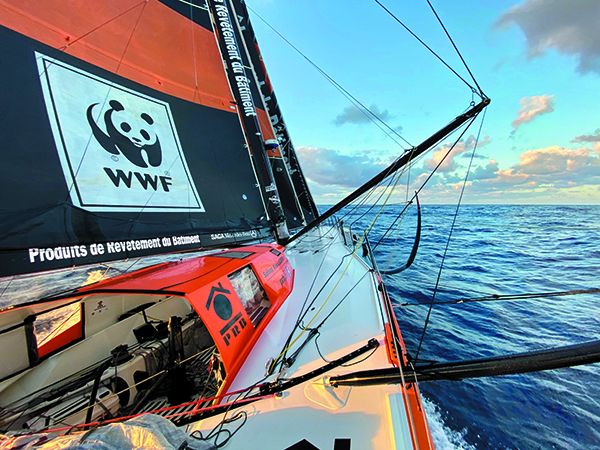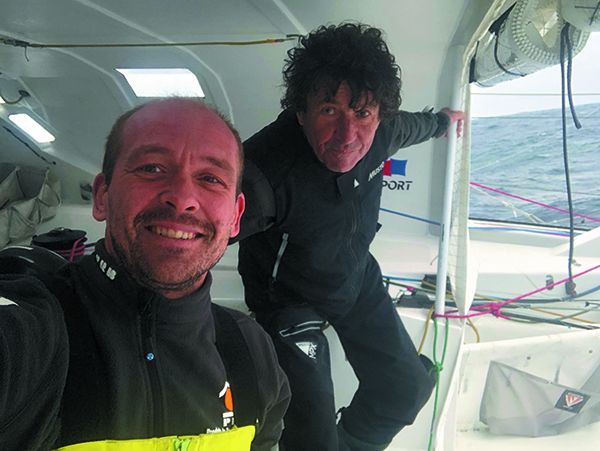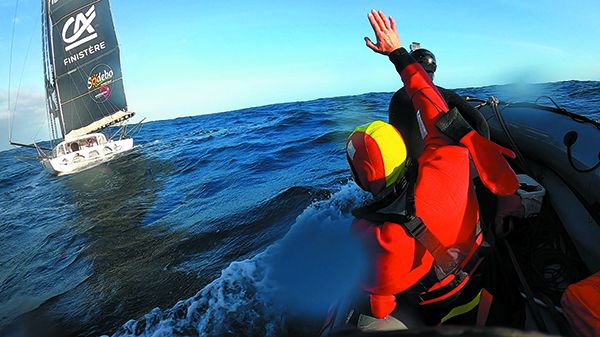Disasters at sea always grab big headlines. But very few of these accounts deliver as much good news and valuable lessons learned as the recent rescue of solo sailor Kevin Escoffier.
Escoffier’s survival story is more than a summary of safety gear. There’s no question that an EPIRB beacon, a survival suit and a seaworthy life raft have once again proven their worth. But his rescue was also made possible by the way solo sailors provide assistance to other solo sailors. The credits don’t end there. Topping the unsung heroes list are race organizers, especially the Vendée Globe Race Direction team. Also playing a role were Escoffier’s shoreside crew, the EPIRB beacon trackers in France and South Africa, and the staff at Meteo France who created set-and-drift scenarios that helped to coordinate the rescue. In fact, saving Escoffier was a super-demonstration of how a shoreside team and a solo sailor can collaborate on a rescue over 8,000 miles away.
On Day 22 of the 2020 Vendée Globe Race round-the-world, Escoffier’s foil-equipped IMOCA 60, PRB, was flying over and diving into riled up seas at a turbocharged 27 knots. The boat and skipper were in third place and surfing down steep wave faces that were spawned by an approaching frontal boundary. The steep, short-period wave faces made the descent into the troughs even more dangerous.
During one of these nosedives, PRB rooted her bow and plunged even deeper into incompressible green water. The loads on the hull skyrocketed and a loud crack spelled disaster. The hull behaved like a massive beam structure that had exceeded its structural safety factor—redlining its stress/strain curve. The carbon fiber hull laminate suffered an ultimate failure, and the hull split in two, buckling just forward of the mast. The rig came down and PRB’s bow was left pointing skyward, looking more like a half-open jackknife than an ocean racing sailboat. Seawater flooded into the hull and Escoffier had very little time to make life-or-death decisions and to implement his plan for survival.
Fortunately, the vessel’s 406 EPIRB, a cornerstone of Global Maritime Distress Safety System (GMDSS), automatically activated. The water level in the boat continued to rise, but in reality, the water wasn’t rising, it was the vessel that was sinking into the abyss. Escoffier adapted to the chaos and switched gears into survival mode. Just before PRB’s battery bank submerged and the electrical system self-destructed, he sent a satellite radio text message to his technical team in France. The 11-word understatement read—“I need assistance. I am sinking. This is not a joke.” The cryptic Mayday stirred things into action.
Hull Failure
The Vendée Race is an epic challenge. When the breeze is up and the seas have been building, the race becomes the equivalent of a free climb up the slab face of Yosemite’s El Capitan. From start to finish, the Vendée is a tactical challenge that tests both the physical and psychological readiness of each singlehander.
The solo event hinges on the work of a design team, boat builder, equipment manufacturers, rigger and shore side supporters. Ultimately, it measures the merit of a solo sailor’s decision making. In some ways, it’s a big-league version of what every racer and cruiser contends with—an ongoing decision-making process about how hard to push the boat and how much sail to carry.
Skipper Kevin Escoffier was prepared, and ocean tested for the challenges of a non-stop, solo, round-the-world, Vendée Globe Race. But the seagoing, 40-year-old, rugby player had no idea how valuable his fitness and agility would prove to be. For three weeks he had been pushing PRB and acclimating to the massive, 300m² ( upwind) and 600m² (downwind) sail plans.
On the 22nd day of the race, Escoffier was in third place, headed eastward with a gusty 25-30 knot southwesterly setting the tempo. A short period, steep wave-train turned the pothole-like wave troughs into deep trenches.
Eventually, 27 knots of boat speed and a bow-down angle of attack caused the stem to bury itself in the back of a wave it should be climbing over. The net effect was a tug-of-war among competing forces. Buoyancy derived from the submerged volume in the forward section of the boat combined with hydrodynamic lift to oppose the nosedive. Rig loads and deceleration added additional forces to the equation. The down angle of attack and locked-in foils bolstered the opposing forces. Something had to give.
Damage control was off the table. Almost by reflex, Escoffier shifted to an abandon-ship mode. Seconds and minutes counted and his “not-a-moment to-spare” approach included a hurried Mayday message, donning of a survival suit that he kept ready, and a quick check of the debris field before launching the life raft.
His abandon-ship effort was complicated by the mast, standing and running rigging slashing through the water as the foundering hull was washed by waves. Escoffier was concerned about launching the raft and having a ballast bag snag the spar or rigging. He cleared the obstacles and was glad to have some survival supplies in the raft, because his grab bag had been out of reach in a submerged portion of the hull.
Commercial mariners are trained to make effective decisions in extremis. Time is of the essence in situations such as fire, flooding, collision, etc. And prioritizing the key steps to survival is paramount. Every accident investigator scrutinizes the steps taken by the crew as well as how the equipment they utilized functioned. Escoffier deserves high marks for his quick, almost instinctual transition from a focus on performance to one of survival.

wave, causing it to crack nearly in half at the mast. “It was at 90 degrees,” he said.

The Escoffier rescue was both a success story and a good lesson about decision making in extremis. Right from the start Kevin settled on a sensible set of priorities, sidelining damage control in favor of abandoning ship. Even though PRB was disintegrating around him, he transmitted a Mayday message and ensured that his EPIRB had auto-activated. He knew he had only a few fleeting minutes to don his survival suit, ready his life raft, and gather what he could prior to abandoning ship. The decision to write off the grab bag was a tough call, but getting the raft launched, boarding, and clearing the rigging mine field were even important priorities.
A key factor in the success of Escoffier’s rescue by another solo sailor is the role played by a team of shore side experts. The first to engage was Vendée Globe’s “Race Direction”, who acted as a virtual crew, guiding fellow sailor Jean Le Cam to Escoffier’s life raft. This support in finding the needle in a haystack and guiding the rescuer to that location tested both communication equipment and the position finding capability of the COSPAS/SARSAT system.
There’s both a bit of irony and a lot of common sense involved in this rescue. The irony lies in the fact that when solo sailing goes awry, it takes a village, a sky full of satellites and the well proven effectiveness of GMDSS to affect a rescue. In this case, shore-based responders became a de-facto part of the crew. And as with many sea going disasters, the onset was lightning fast, but the following 11 hours seemed an eternity.
The 406 EPIRB signal was received by CROSS Griz Nez in France who alerted Vendée Globe headquarters. They electronically scanned the fleet and saw that Jean Le Cam was the closest competitor. He changed course to rendezvous with Escoffier and his life raft.
This was a collaborative rescue and every major ocean race organizing committee should take note of how it unfolded. The international GMDSS system relayed location information to Race Direction because the French RCC and the Vendée Globe Race had previously agreed on this approach. Race Direction took on the role of primary rescue coordinator and implemented its plan to divert other competitors to the location of the vessel in distress—in this case, a competitor in a life raft.
The upside in this approach is multifaceted. It puts those who have the best understanding of sailors and sailboats in a particular event in a pivotal role. If they have an effective communications system and other competitors in the area such an approach makes sense. In cases where such organization is not an option, or where coastal SAR organization such as the US Coast Guard are available, the latter will become lead agent in the rescue effort.
Not only did Race Direction take the lead in this well executed rescue effort, but it became a real time collaborative effort among oceanographers at France’s MOTHY calculating Escoffier’s life raft’s set and drift and search patterns and RCC’s in France and South Africa. All was expedited by excellent satellite communications between vessels and rescue coordinators separated by thousands of miles.
Long term, life raft survival sagas have been greatly reduced thanks to the COSPAS/SARSAT beacon response system.

Cold Water SOS
Within minutes of the hull failure he faced one of a sailor’s worst nightmares. His seemingly seaworthy boat had disintegrated around him and his life depended on an inflatable life raft. The shock of abandoning ship approximately 840 miles southwest of Cape Town, SA, in big seas and 50°F water wasn’t easy to take in stride. The seas were very rough as the South Atlantic Gyre intersected the cold Benguela current. Escoffier understood the implications of heavy seas and hypothermia and knew that his survival depended on three things, his survival suit, the life raft and the location updates broadcasted by his 406 MHz EPIRB. Ironically, a small DC lamp on the canopy of his raft would also play an equally important role.
During WWII, the US Navy discovered that if a shipwrecked sailor survived the first 10 minutes, and boarded a raft or lifeboat, their odds for surviving for days increased. If fresh water was available, the few day survival stats could stretch into weeks. Escoffier had no desire to spend weeks in the raft and the his odds of a more immediate rescue increased thanks to his EPIRB. The beacon is a mainstay of the GMDSS network (see page 7, “Global Rescue Network is Good as Gold”). It sends a 406 MHz digital signal to a geostationary, low earth orbit or to newer, mid-earth orbit-satellites that are part of the COSPAS/SARSAT array.
The upside of this technology is the global response it leverages. Once a signal is received in any remote corner of the world, the satellite(s) forwards it to the nearest LUT (local user terminal) which processes the signal and sends it on to a Mission Control Center. The MCC matches the data with other signals and sends the alert to the closest Rescue Coordination Center. The RCC contacts listed phone numbers and attempts to ascertain the validity of the alert. In Escoffier’s case, the listed contact was the Vendée Globe Race Direction, the shoreside race management team in regular radio/video contact with the fleet. This EPIRB shortcut to verification, combined with the sat phone message to Escoffier’s shore-based team, quickly put into motion a well-planned rescue effort.
The closest RCC was MRCC South Africa, who, along with CROSS Griz Nez, France (another COSPAS/SARSAT search and rescue link), collaborated on the beacon fix. At Meteo France, meteorology and oceanography experts developed drift predictions for the region and Race Direction vectored Jean Le Cam on a course that would intersect Escoffier and his raft. However, the EPIRB position kept skipping around, and the team worried that it was not attached to the raft. Eventually, the signal coincided with the projected drift simulation calculated by Meteo France’s MOTHY.
Solo sailor Jean Le Cam was sent toward the location, and he initially
sighted what he assumed was the raft light. Unfortunately, this initial contact was lost and Le Cam continued to search the area. No AIS beacon signals were received, likely a result of the steep seas and line-of-sight nature of the beacon system. Meanwhile, Race Direction called on three other competitors in the region to steer toward the EPIRB signal, so a triangular search grid pattern would be implemented. Finally, Le Cam again spotted a light in the distance. He approached the raft under a double reefed mainsail and made contact with Escoffier who was ready for a rescue.

Kevin Escoffier’s IMOCA 60 PRB was a proven performer, designed by Verdier-VPLP, built by CDK Technologies and launched in 2010 for her original owner, Vincent Riou. In 2013 and 2015 he won the Transat Jacques Vabre, plus finished fourth in the Route de Rhum. Foils were added during a 2017 refit, and the makeover produced what seemed to be a solid, very competitive boat for the Vendée Globe 2020.
The great conundrum faced by sailboat designers is that many, if not most, ocean races are won or lost during the light air episodes. Consequently, light displacement and large sail area are favored design features. But as many old salts have muttered, “you can’t win if you don’t finish.” The net result of these conflicting goals is a need to engineer an appropriate structural safety factor into the key elements of an ocean racer.
Naval architects have lots of trial and error knowledge about keel to hull attachment and how much dynamic loading takes place in a sea way. It’s at high-stress areas on a sailboat where the argument for extra reinforcement rings clear. So it stands to reason that adding wing-like lifting foils to a sailboat should be treated accordingly. The trouble is, sailboats haven’t been flying over storm tossed seas while riding on lateral appendages for very long. And these performance-boosting lifting surfaces also act like crowbars attempting to split the hull wide open. The data going into finite element analysis (FEA) computer programs is incomplete and may not hold the full picture of what goes on when a 60-footer nose dives into a steep trough, churned up by a storm tossed sea.
Structural fatigue is another concerning nautical question mark. And in this case, PRB was a ten-year old IMOCA racer that had competed in 26 major ocean races—many of which were Transatlantics. Two prior Vendée Globe attempts faltered due to hull damage that led to withdrawals from the race. The sum total of sea miles and how hard the vessel was pushed is hard to enumerate, but naval architects and structural engineers agree that structural fatigue and age have a negative impact on composite structures.
In 2017 PRB went through a refit that included installing a set of wing like foils that added a significant performance uptick. The beneficial result included an increase in sustained speed, velocities never imagined during her original design. Such major modifications posed a significant engineering challenge. It should include a reassessment of primary, secondary and tertiary hull bending moments, along with an analysis of where new loads would be focused and the stress risers they would create. It’s relatively easy to determine static tension, compression and shear loads, but it takes more than computer modeling to pin down the dynamic effect linked to prolonged, high speed sailing in an angry ocean.
The ISAF technical committee has recently been reviewing keel attachment problems and some of their preliminary findings are cause for concern. One of their observations is that offshore race boats have a functional life span of ten years. Thus, adding foils to an older, heavily campaigned sailboat carries multiple engineering challenges. Firstly, the point loads linked to mounting the foils, another high aspect ratio hull appendage, needs to be addressed. Secondly, the effect of cycle loading and structural fatigue in older, heavily sailed boats should be considered. Determining just how deteriorated and older FRP hull/deck structure has become is currently more subjective than objective. Add to this, the new challenges imposed by repeated “crash landings” and higher velocity wave impacts and it becomes clear that the foiling Vendée Globe solo sailor is both an extreme sport sailor and a nautical test pilot.

The wind was down a bit, but the seas were confused and maneuvering was difficult. As Le Cam steered his IMOCA 60 to windward of the life raft, she started to go gain sternway. Le Cam had a trusty ring buoy and line ready, and when Escoffier was a just a few meters away, he heaved him the ring. Both hauled in on the line and as the raft neared the stern of Yes We Cam, Kevin lunged for the stern grabbing onto a connecting rod that linked the two rudders. With an apology to Le Cam for intruding on his race, Escoffier was welcomed aboard. But it wasn’t until someone at Race Direction headquarters noticed the video link, and they saw that there were now two sailors aboard Yes We Cam. A cheer rose in the room—the collaborative rescue had worked.

Shortly after his rescue Kevin Escoffier recounted his tale for the media, via the Vendee Globe press office. Here is an excerpt of the English translation of his first full interview. The full interview is available at the Vendee Globe website (www.vendeeglobe.org/en/news/20722/relieved-escoffier-speaks-about-his-rescue-by-jean-le-cam).
“It’s unbelievable what happened. The boat folded up on a wave at 27 knots. I heard a bang, but to be honest, I didn’t need to hear that to know what had happened. I looked at the bow. It was at 90°. In a few seconds, there was water everywhere. The stern was under water and the bow was pointing up to the sky. The boat split in half in front of the mast bulkhead. It was as if she folded up. I promise. I’m not exaggerating. There was an angle of 90-degrees between the stern and the bow.
“I didn’t have time to do anything. I just had time to send a message to my team. I’m sinking I’m not joking. MAYDAY. Between the moment when I was out on deck trimming the sails and when I found myself in my survival suit, barely two minutes had passed. It all happened extremely quickly.”
“I came out of the boat and put on my survival suit. I could see smoke. The electronics were burning. Everything went off. My only reflex was to grab my telephone to send the message and pick up the survival suit which I never stow away. I wanted to pick up the grab bag, but I couldn’t get to it with the water rising. I grabbed the liferaft at the stern. I couldn’t get into it as it was three metres under the water. The water was up to the door in the cockpit.”
He continued, “For me I was going to stay the whole night in the life raft, that was what I was thinking, it was okay for me, it was safer to switch from one to the other with less winds and less waves. I spent the night quite well, I mean I wasn’t comfortable, but in my head it was better, I was sure that the day after someone would be coming with less winds and less waves, and then I’d be able to get from the life raft to the boat.
I had a bit of trouble sleeping during the night, I had been eating a bit and drinking the water I had on board. Close to the morning I heard a sail flapping so I got out, had my head out of the life raft and I saw it wasn’t dark anymore because of the moon, even with no sun we were able to see very well and I saw Jean just above me, at 100/200 metres from me, I asked him ‘Now, we’re doing it now?” and he said ‘Yes yes let’s do it now.’

Conclusions
Planning a response to a disaster at sea is far easier said than done. The main reason for this is that catastrophic failures have their own timetable. The most serious incidents occur as an abrupt, unwelcome capsize of the status quo. Such events usually involve heavy weather, too much sail area or both. Maritime catastrophes are often labeled as “operator error,” but close on the heels of this cause is material failure. In this case, one might say that dialing back on sail area and slowing down would have eased the loads that PRB had to endure, and perhaps prevented the hull failure. But the word “race” tends to preclude any such precautionary approach.
In an automobile, the driver and passengers are surrounded by their safety equipment. Side impact protection is engineered into the frame of the vehicle, seatbelts have warning buzzers and airbags auto-deploy. The sailor in extremis faces a much less automated pathway to survival. When a massive hull failure occurs, time is of the essence and several critical steps must be taken to survive the initial challenge of abandoning ship. Escoffier reached for the tried and proven basics—a COSPAS/SARSAT beacon, his survival suit and a liferaft. Lots of other gear might have come in handy, but Kevin Escoffier had his priorities right.
In part two of our reporting on this topic, we will delve into how the addition of a MEOSAR array of satellites, along with a new genre of EPIRBs, has bolstered beacon technology and made the backbone of GMDSS even better.
Ralph Naranjo, PS editor-at-large, is an adjunct lecturer at the Annapolis School of Seamanship and the author of The Art of Seamanship: Evolving Skills, Exploring Oceans, and Handling Wind, Waves, and Weather, a comprehensive textbook aimed at the advanced cruising sailor. In part II of his reporting on the Kevin Escoffier’s rescue, he will look closer at the latest SAR tools.








































